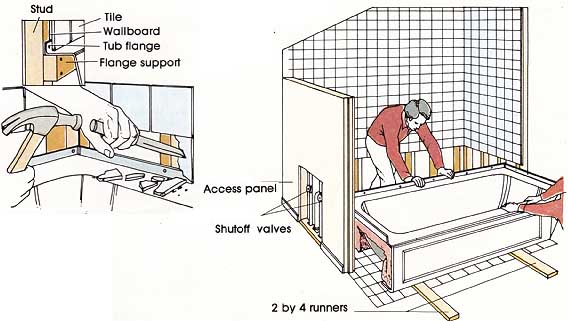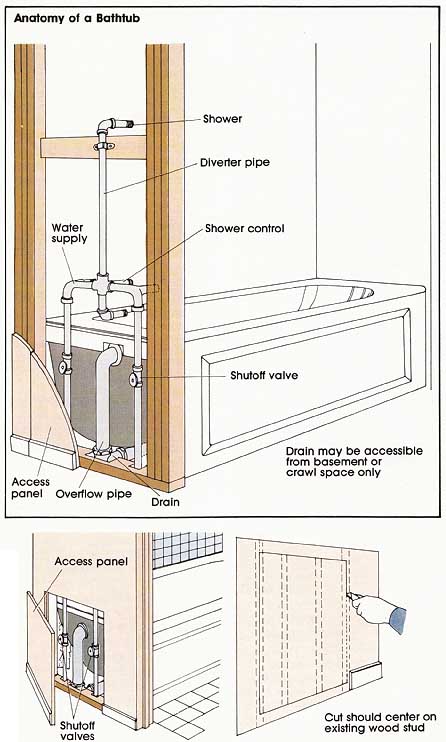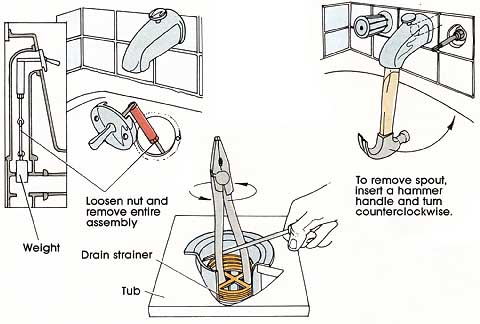The bathtub is the hardest of all bathroom fixtures to re move. Plan for at least two assistants. The size of your tub and bathroom may require you to remove the washbasin, toilet, or any other elements that obstruct its removal, tub to remove the flanges from the studs. If you have an attached glass shower door at the open side of your tub, you will have to remove that first. If you have a freestanding tub, like the old Victorian clawfoot tubs, you can probably see all the plumbing connections. If your tub is set into one or more walls, it probably has a flange buried in each wall, and you will have to chip or cut into the wall all around the
1. If you have a freestanding tub, turn off the water at the shutoff valves and proceed to Step 3. Some bathrooms have an access panel to the tub’s in-wall plumbing. It will be located near the floor on a wall adjacent to the plumbing end of your tub. The panel will be a simple piece of plywood, usually framed and painted over to make it inconspicuous. Pry the panel loose, and turn off the water at the shutoff valves. If your tub has no access panel, it may have no shutoff valves. There is no way to know without going into the wall. You can make a panel by cuffing into the plumbing wall. If you find no shutoff valves, turn the water off at the main, and consider installing shutoff valves for future use.
2. To cut an access panel, locate the wall closest to the plumbing end of your tub. Find the two studs on either side of, and closest to, the drain. Turn off the electricity to your bathroom because you may en counter wires in the wall. Then, starting 2 inches above the floor or baseboard, use a utility knife to cut out the section of wall between the studs, which are spaced 16 inches on center in most newer houses and 24 inches o.c. in some older ones. Cut the section about 14 inches high. You can also use a saber saw for this task, but you are less likely to hit water pipes or cut electrical wires with a utility knife. Remove the section of wall, and close the shutoff valves. If there are no valves, shut off the building’s main water supply. Plan to install shutoff valves for your new tub and to keep your access panel.
Tools: magnetic stud finder or 6d nails; utility knife or saber saw; screwdriver; pliers; hammer; cold chisel; pry- bar; two 1 by 4 runners, 3- to 4-feet long; dolly.
— Shower
— Diverter pipe
Shower control; Drain may be accessible from basement or crawl space only; Cut should center on existing wood stud
3. Turn on the faucets, and let the water in the supply lines drain out. Remove the overflow plate, which is usually located just below the spout, and pull out the entire mechanism.
4. Disconnect the tub from its drain pipe by removing the drain strainer and the overflow control. You may have to pry up the drain strainer with a screwdriver. When the strainer and overflow control have been removed, insert the handles of a pair of pliers into the drain’s crosspiece, and turn them counterclockwise. If necessary, use a screwdriver as a prybar to turn the pliers. When the crosspiece turns freely, you have disconnected the waste pipe from the overflow pipe. If the crosspiece resists all your efforts, you’ll have to get at the pipes through your access panel.
Drain strainer; Tub
5. Remove the faucet and spout assemblies from the wall. If yours is a freestanding tub, remove assemblies from the supply pipes and then remove the tub from the bath room using two or three assistants and a dolly.
6. To remove an in-wall tub, use a cold chisel and a hammer to chip or cut away the molding, tile, or other wall covering around your tub. Chip to a height of 4 inches or one course of tile, whichever is greater. (See below for more in formation about removing tile.) If the flanges are anchored to the studs with nails or screws, remove them.

59b Access panel; Shutoff valves
Weight
To remove spout, insert a hammer handle and turn counterclockwise.
7. Using a prybar and a couple of assistants, raise one end of the tub until you can slide a 3- to 4-foot length of 1 by 4 beneath it, all the way to the far wall; then do the same at the other end of the tub. Pry and pull the tub away from the wall until you or one of your assistants can stand behind it; then pry, pull, push, and tilt the tub out of its recess. It may be necessary to stand the tub on end to get it through your doorway, in which case set it on the dolly outside the room.
Next: Dismantling Shower Stalls
Prev.: Dismantling Toilets

